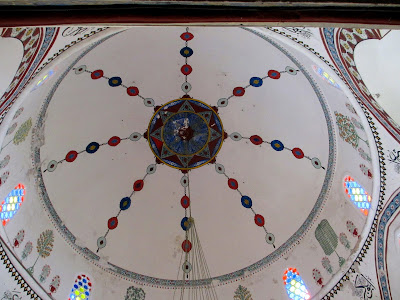Mostar is the fifth largest city in Bosnia and Herzegovina and is famous for its beautiful white bridge over the Neretva River.
Stari Most ("Old Bridge")
The Stari Most ("Old Bridge" in English) was commissioned by the Ottoman ruler Suleiman the Magnificent in 1557 and was completed in 1566 or 1567. When it was built, it was the widest man-made arch in the world. After standing for 427 years, it was destroyed by tank fire from Bosnian Croat forces in November 1993. It was rebuilt and opened in July 2004. Local divers stand at the top of the bridge, and after extracting as much money as they possibly can from the tourists that crowd around to watch, they jump 69 feet (21 meters) from the bridge into the river.
 |
| Stari Most. |
 |
| Diver teases the crowd in an attempt to extract more money before jumping off the Stari Most. |
Koski Mehmed Pasa Mosque
Koski Mehmed Pasa Mosque was built in 1617 or 1618, apparently by Koski Mehmed Pasha. I have been unable to find anything about Koski Mehmed Pasha. Mehmed is the most common Turkish form of the Arabic name Muhammed. Mehmet is another variation in Turkish influenced cultures, such as the Balkan Muslims. Pasa appears to be a derivation of pasha, which was a high rank in the Ottoman Empire political system, an honorary title granted to governors, generals and dignitaries, similar to the British title of Lord. Pasina also appears to be a derivation of the same word.
The mosque is visible from the Stari Most and is on a bank above the Neretva River. Many people that visit the mosque do so because it has a great vantage point for taking pictures of the bridge. The mosque, like the bridge, was virtually destroyed during the 1992 to 1995 war, but it was rebuilt and reopened in 2001.
 |
| Koski Mehmed Pasa Mosque from the bridge. |
 |
| View of the bridge from the mosque. |
The minaret is the tall spire near the mosque. It usually includes a base, a shaft and a gallery. The minaret provides a visual indication of the location of a mosque and the place for the call to prayer to be broadcast. Today, most of the calls to prayer are done using a microphone to speakers on the minaret. The call to prayer is made five time daily: at dawn, at noon, at mid-afternoon, at sunset and at night.
 |
| The minaret of Koski Mehmed Pasa Mosque rises up to the right. |
A sadirvan is a fountain built in the yard or entrance in front of a mosque. It provides water for drinking or ritual ablutions to multiple people at the same time. It is a common element in Ottoman mosques.
 |
| The sadirvan in front of the mosque. |
 |
| Covered entrance to the mosque. The entrance is usually opposite of the mihrab. |
The minbar is the pulpit in the mosque where the imam delivers sermons. It is shaped like a staircase with a pointed roof at the top. It is usually located to the right of the mihrab.
 |
| The minbar is to the right of the mihrab, just visible to the left. |
The qibla is the direction a Muslim faces when he or she prays. It is the direction of the Kaaba in Mecca, Saudi Arabia. Mosques have a wall niche called the mihrab that indicates the qibla and that wall is known as the "qibla wall."
 |
| Colorfully decorated mihrab. |
The dome is usually directly above the main prayer hall and signifies the vaults of heaven and the sky.
 |
| Inside of the dome. |
 |
| Close-up of decoration inside the dome. |
 |
| A partial dome. |
The prayer hall, or musallah, does not have chairs so that as many people as possible can be in the room.
 |
| Rugs spread out on the floor, as well as this one up against a wall. |
Islamic art is not representational. Particularly when dealing with images of God, Muhammad, the Islamic prophets and relatives of Muhammad, but even humans and animals. So Islamic art tends to focus on symmetrical and geometric designs, calligraphy, abstract designs and barely representational foliage patters. Avoidance of idolatry is the main concern. This varies by region and some regions are much more strict than others. The Balkans tend to be much less conservative than other areas of Islam because of the close proximity of many Christians.








The bridge has to be one of the most picturesque sites in the Balkans. Like a Lay's potato chip, no one can take just on (picture).
ReplyDeleteI love the domes of mosques and churches. They are always so interesting. It is interesting to read the "why" of all of the shapes and plant decorations of Islamic mosques.
ReplyDelete